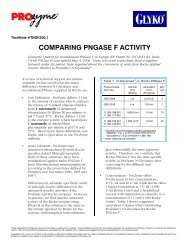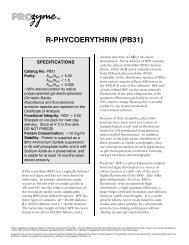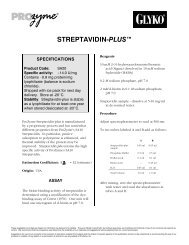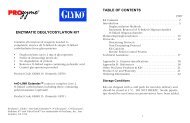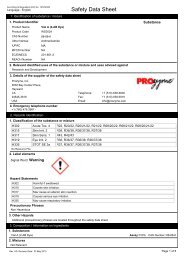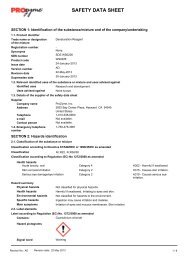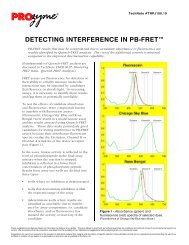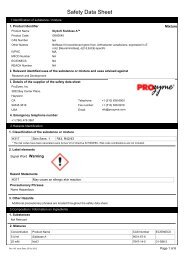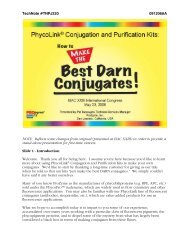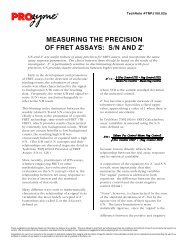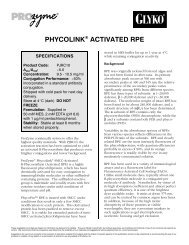FACE® N-Linked Oligosaccharide Profiling Kit - ProZyme
FACE® N-Linked Oligosaccharide Profiling Kit - ProZyme
FACE® N-Linked Oligosaccharide Profiling Kit - ProZyme
Create successful ePaper yourself
Turn your PDF publications into a flip-book with our unique Google optimized e-Paper software.
SECTION 5<br />
PROCESSING OF FACE OLIGO PROFILING GELS<br />
Following Step 14, above, carefully remove the gels from the electrophoresis tank.<br />
I. Gel Imaging using the UV Transilluminator (lightbox)<br />
CAUTION:<br />
UV-protective eyewear or face shield should be worn. Avoid prolonged exposure to UV<br />
light.<br />
1 Allow UV lightbox to "warm-up" for at least 2 minutes in order to get maximum intensity output.<br />
The lightbox must be long-wave UV (UVP Model TL-33 or equivalent) and have a peak output at<br />
approximately 360 nm; this is not the type of box typically used for ethidium-stained DNA gels.<br />
2 Optional: To increase sensitivity you may wish to peel the tape from the gel cassette, and<br />
disassemble the cassette by carefully prying open the two glass plates, removing the gel completely<br />
from the cassette and placing it directly on the UV lightbox.<br />
Images of gels can be recorded using a Polaroid camera. The proper choice of light source, filters and<br />
film must be made. A filter must be fitted to the camera lens, which completely covers the glass of the<br />
lens, stray UV contacting the lens will cause it to fluoresce and subsequently lower the sensitivity of the<br />
film. A Kodak Wratten Number 8 filter is suggested and can be purchased from Kodak and Kodak<br />
distributors. A suitable filter will have no inherent fluorescence, peak transmission at approximately<br />
500 nm, and bandwidth of 80 nm FWHM.<br />
A medium speed, medium resolution, Polaroid film is recommended. Use Polaroid 53 film for cameras<br />
that use single 4"x 5" sheet film; use Polaroid 553 film for cameras that use 8 sheet film cartridges.<br />
Photographing Gels:<br />
1 Photograph the gel using the lowest practical F setting on the lens, with the gel filling as much of<br />
the frame as possible. In our experience, exposures at F5.6 using Polaroid 53 film have ranged from<br />
5 to 40 seconds using the equipment specified above. KEEP UV EXPOSURE OF THE GEL TO A<br />
MINIMUM TO PREVENT BLEACHING.<br />
Page 18



